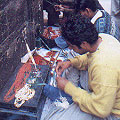Jamakkalam handloom weaving has been recognized as a symbol of India’s traditional cultural heritage with modern functionality across the globe. Originating from the Erode district in Tamil Nadu, this special type of weaving has been practiced since the colonial times in Bhavani town. It received the status as a Geographical Indication in 2006 and since has been an object of textile heritage. Although Bhavani Jamakkalam is typically weaved in the form of carpets and blankets, there is surging demand in new markets of production.
The weaving has been recognized as authentic to the Bhavani town which is known for its enormous textile industry. Its second name is the “Carpet City” which then grants more fervor to the location and increases its cultural and economic value. The industry started to become independent and claim ownership since the colonial rule. During this time, in the 19th century, a group of weavers called the Jangamars started producing blankets using coarse cotton threads that were called as Jamakkalam (Neve 2005). Its popularity led to the replacement of traditional saris and clothes, making it a signifier of cultural strength and nationalism. Since then, the weaving is done in two ways, depending on the purpose of production. The first type of Jamakkalam is made using coarser cotton threads which are dyed into colors. Since the rough raw material is used, the designs are not too intricate and it results in the making of carpets with colorful bands. The second type results in detailed designing that is produced as bags and saris. The raw material used in this kind of weaving is artificial silk which is soft and can be woven in different designs. The Jamakkalam saris would have border designs and giving the traditional weaving a modernistic fashionable edge. The weaving is conducted using pit-looms which are made of wood. The arrangement of the loom is such that the threads are stretched horizontally from end to end. The weaver operates the loom through pedals with his legs and constructs the design by enabling the shuttles to move across and over the threads stretched.
Traditionally, the Jamakkalam production would take place in the houses of the weavers independently. Since the 19th century, there has been an expansion in production and investment in technology that has led to the weaving being was carried out on handlooms in specialized centers of artistry supervised by the master weavers. The industry occupies most of the population in Bhavani, with women forming two-thirds of the workforce. Since inception, the industry has been supporting many livelihoods and hence, it requires immediate investment and transformation to match with today’s healthy living standards. In addition, there is a high need to safeguard this industry from increasing competition and preserve the art as a part of India’s heritage (Hussain 2019). However, with increasing taxes and high cost of production, there is a constant negotiation with the industry and the weavers. Hence, even after being featured in the stores of the leading Swedish housing company- IKEA and gaining exposure worldwide, there is a pit of empowerment that has to be filled for Jamakkalam as an art and the weavers.
Gallery
YOUR VIEWS
PRACTITIONERS: INDIA
Access 70,000+ practitioners in 2500+ crafts across India.
BIBLIOGRAPHY
10,000+ listings on arts, crafts, design, heritage, culture etc.
GLOSSARY
Rich and often unfamiliar vocabulary of crafts and textiles.
SHOP at India InCH
Needs to be written.






